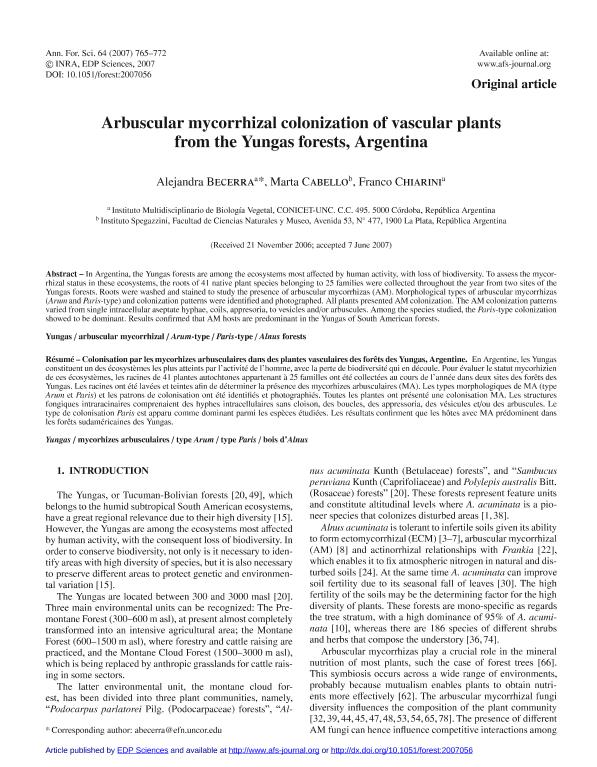Mostrar el registro sencillo del ítem
dc.contributor.author
Becerra, Alejandra Gabriela

dc.contributor.author
Cabello, Marta Noemí

dc.contributor.author
Chiarini, Franco Ezequiel

dc.date.available
2018-02-28T17:23:19Z
dc.date.issued
2007-10
dc.identifier.citation
Becerra, Alejandra Gabriela; Cabello, Marta Noemí; Chiarini, Franco Ezequiel; Arbuscular mycorrhizal colonization of vascular plants from the Yungas forests, Argentina; EDP Sciences; Annals of Forest Science; 64; 7; 10-2007; 765-772
dc.identifier.issn
1286-4560
dc.identifier.uri
http://hdl.handle.net/11336/37393
dc.description.abstract
In Argentina, the Yungas forests are among the ecosystems most affected by human activity, with loss of biodiversity. To assess the mycorrhizal status in these ecosystems, the roots of 41 native plant species belonging to 25 families were collected throughout the year from two sites of the Yungas forests. Roots were washed and stained to study the presence of arbuscular mycorrhizas (AM). Morphological types of arbuscular mycorrhizas (Arum and Paris-type) and colonization patterns were identified and photographed. All plants presented AM colonization. The AM colonization patterns varied from single intracellular aseptate hyphae, coils, appresoria, to vesicles and/or arbuscules. Among the species studied, the Paris-type colonization showed to be dominant. Results confirmed that AM hosts are predominant in the Yungas of South American forests. © INRA, EDP Sciences, 2007.
dc.description.abstract
En Argentine, les Yungas constituent un des écosystèmes les plus atteints par l’activité de l’homme, avec la perte de biodiversité qui en découle. Pour évaluer le statut mycorhizien de ces écosystèmes, les racines de 41 plantes autochtones appartenant à 25 familles ont été collectées au cours de l’année dans deux sites des forêts des Yungas. Les racines ont été lavées et teintes afin de déterminer la présence des mycorhizes arbusculaires (MA). Les types morphologiques de MA (type Arum et Paris) et les patrons de colonisation ont été identifiés et photographiés. Toutes les plantes ont présenté une colonisation MA. Les structures
fongiques intraracinaires comprenaient des hyphes intracellulaires sans cloison, des boucles, des appressoria, des vésicules et/ou des arbuscules. Le type de colonisation Paris est apparu comme dominant parmi les espèces étudiées. Les résultats confirment que les hôtes avec MA prédominent dans les forêts sudaméricaines des Yungas.
dc.format
application/pdf
dc.language.iso
eng
dc.publisher
EDP Sciences

dc.rights
info:eu-repo/semantics/openAccess
dc.rights.uri
https://creativecommons.org/licenses/by-nc-sa/2.5/ar/
dc.subject
Alnus Forests
dc.subject
Arbuscular Mycorrhizal
dc.subject
Arum-Type
dc.subject
Paris-Type
dc.subject
Yungas
dc.subject.classification
Otras Ciencias Biológicas

dc.subject.classification
Ciencias Biológicas

dc.subject.classification
CIENCIAS NATURALES Y EXACTAS

dc.title
Arbuscular mycorrhizal colonization of vascular plants from the Yungas forests, Argentina
dc.type
info:eu-repo/semantics/article
dc.type
info:ar-repo/semantics/artículo
dc.type
info:eu-repo/semantics/publishedVersion
dc.date.updated
2018-02-14T19:31:14Z
dc.identifier.eissn
1297-966X
dc.journal.volume
64
dc.journal.number
7
dc.journal.pagination
765-772
dc.journal.pais
Francia

dc.description.fil
Fil: Becerra, Alejandra Gabriela. Consejo Nacional de Investigaciones Científicas y Técnicas. Centro Científico Tecnológico Conicet - Córdoba. Instituto Multidisciplinario de Biología Vegetal. Universidad Nacional de Córdoba. Facultad de Ciencias Exactas Físicas y Naturales. Instituto Multidisciplinario de Biología Vegetal; Argentina
dc.description.fil
Fil: Cabello, Marta Noemí. Universidad Nacional de La Plata. Facultad de Ciencias Naturales y Museo; Argentina
dc.description.fil
Fil: Chiarini, Franco Ezequiel. Consejo Nacional de Investigaciones Científicas y Técnicas. Centro Científico Tecnológico Conicet - Córdoba. Instituto Multidisciplinario de Biología Vegetal. Universidad Nacional de Córdoba. Facultad de Ciencias Exactas Físicas y Naturales. Instituto Multidisciplinario de Biología Vegetal; Argentina
dc.journal.title
Annals of Forest Science

dc.relation.alternativeid
info:eu-repo/semantics/altIdentifier/url/https://link.springer.com/article/10.1051/forest:2007056
dc.relation.alternativeid
info:eu-repo/semantics/altIdentifier/doi/http://dx.doi.org/10.1051/forest:2007056
Archivos asociados
